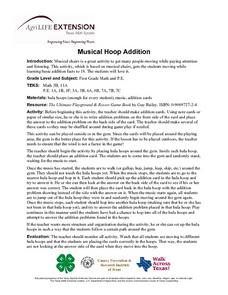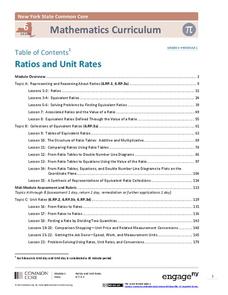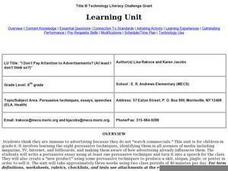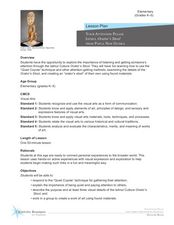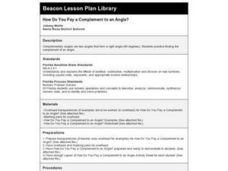EngageNY
Analyzing Main Ideas and Details: Why Care about Water?
Pay attention to details! After completing text-dependent questions about paragraphs 10-12 of "Water is Life," scholars view the video "Why Care about Water. "They view the video three times and use a Main Idea and Details note-catcher...
Academy of American Poets
Teach This Poem: “Dead Stars” by Ada Limón
Pay attention! A lesson featuring Ada Limon's poem "Dead Stars" is designed to help learners develop their noticing skills. Class members first study the constellation Orion's image and list what they notice and how the image makes them...
Curated OER
Convey Ideas in Writing
Write an unsent letter about a consumer scam, paying attention to the writing conventions of punctuation and spelling. This lesson could be adapted to fit a variety of social issues in which letter writing is appropriate. 4
Curated OER
Musical Hoop Addition
Musical chairs is a great activity to get children moving while still paying attention and listening. This activity, which is based on musical chairs, gets students moving while learning basic addition facts. They hop from hoop to hoop...
EngageNY
Ratios and Unit Rates
This turn-key unit on ratios and unit rates walks through a 30-lesson unit on teaching proportional reasoning, with each lesson broken into detailed teaching notes and time allotments for all parts. An unbelievable resource when taken...
Curated OER
I Don't Pay Attention to Advertisements
Sixth graders examine the eight persuasive techniques, identifying them in all avenues of media including magazine, TV, Internet, and billboards, and making them aware of how advertising already influences them. They write an essay using...
Curated OER
"I Don't Pay Attention to Advertisements? (At least I don't think so?)"
Sixth graders study eight persuasive techniques that occur in a variety of media types. They write a persuasive essay and present it to the class. They create a "new product" for which they produce an advertisement using persuasive...
Curated OER
Your Attention Please: Iatmul Orator's Stool
Learners investigate art by observing historical sculptures from New Guinea. For this art history lesson, students observe pictures of the "Orator's Stool"from Papua New Guinea, while identifying the small details that make it unique....
Curated OER
Music: Sounds on the Farm
Singing is a great way to build memory, music, and verbal communication skills. Little ones sing the song, "Old Mac Donald had a Farm." They make the sounds of each animal on the farm paying attention to signaling cues, singing high, and...
Curated OER
What Do Writers Do?
Pupils learn about honing their writing through editing. They write the beginning of a story, paying attention to vocabulary and detail. Then they split into groups of two to peer edit. After discussing ways they can improve their...
Curated OER
A Tale of Two Cities Quiz
It was the hardest quiz, it was the easiest quiz - but really, it shouldn't be too difficult. Charles Dickens' A Tale of Two Cities is the focus of these ten multiple-choice questions. See how well your readers are paying attention!
Curated OER
Addition Practice
Give your mathematicians a leg up on simple addition using this activity with visual aids. Similar to counting cubes, each single-digit addend is accompanied by a corresponding number of colored squares. The two colors are joined where...
Curated OER
Subtraction and Unknown Addends
Using images helps budding mathematicians grasp difficult subtraction concepts. In this set of three word problems, they examine sets of objects which are reflected in each scenario. To approach subtraction in a more accessible way, the...
Curated OER
Graphs to Represent a Data Set
As your scholars begin to learn how to read graphs, help them pay attention to detail with this matching activity. They read four short data descriptions and match them to one of the four bar graphs pictured. Each graph is labeled along...
Curated OER
Area of Rectangles in Word Problems
Apply area calculations to everyday situations using these three word problems. Mathematicians must pay attention to the needs of each space, determining the largest or smallest area of several options. Consider expanding on this by...
Curated OER
Joyful Noise: Poems for Two Voices by Paul Fleischman
Do your young readers know that poems can be performed as a team? They listen to a few examples from Paul Fleischman's book Joyful Noise: Poems for Two Voices, paying attention to how the how readers work together. They examine the...
Alabama Learning Exchange
Origami Geometry
Origami is an excellent way to combine Japanese culture, art, and geometric shapes into one engaging instructional activity! Scholars begin by listening to the story Sadako and the Thousand Paper Cranes and learn the origin of the...
Do2Learn
Self Monitoring Sheet
Instill self-checking skills in your pupils by asking them to pay attention to how they do in each class. Learners set goals for each class, take notes on their performance, and fill out reflection questions at the end of the day.
Curated OER
Exercise in creating drawings for field notebooks
Learners (with a partner) draw and describe a leaf in its natural setting, and then re-find leaves drawn and described by classmates. The point is to have them start to think about observations in science, what to put in a field...
PBS
Supernatural Shakespeare and Macbeth
"A drum, a drum! Macbeth doth come." The withered and wild witches of Shakespeare’s Scottish play launch an examination of the fantastical elements in Act I, scene iii, paying particular attention to the action, imagery,...
EngageNY
Building Background Knowledge: The Internment of Japanese-Americans during WWII, Part 1
It is all in the details. Scholars read The Life of Miné Okubo and pay special attention to details that reveal Okubo's character. Completing their Understanding Miné: Character Traits graphic organizers and recalling the descriptions...
Curated OER
The Real Tooth Fairy
First graders listen to the story "The Real Tooth Fairy and explore the concept of mental images. In this mental image lesson, 1st graders create a mental image of what the tooth fairy looks like. Students listen to the teacher model...
Curated OER
How Do You Pay a Complement to an Angle?
Learners observe and solve examples of the complementary angle theorem. They complete the How Do You Pay a Complement to an Angle worksheet, and write a response in their math journal.
Transforming Education
Self-Management Strategies
What self-management techniques help scholars achieve their goals? Readers review a list of strategies for managing stress, increasing motivation, and setting goals. They discover how to monitor their emotions, create checklists to stay...





